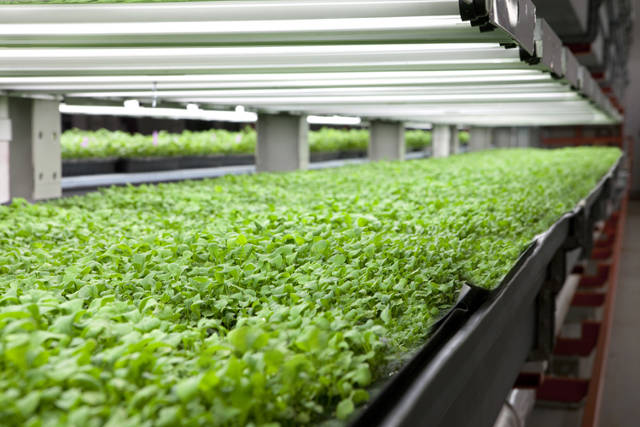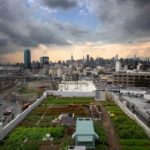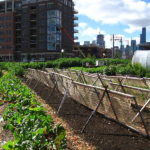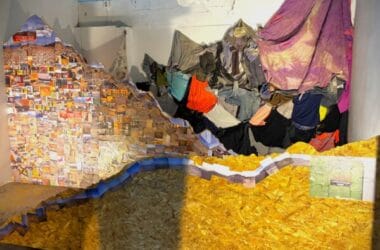Urban Farming and its vertical indoor application have become all the rage. We look at a project in Chicago and question whether the craze will matter for the future of agriculture.


FarmedHere: The Nation’s Largest Indoor Organic Farm Now Growing in Chicago
by Bridgette Meinhold, Published in Inhabitat
The nation’s largest indoor organic farm is now churning out greens and herbs to supply the Chicago area with fresh, local produce. FarmedHere in 2013 opened an aquaponic and aeroponic farm in a 90,000 square foot post-industrial building in Bedford Park, IL. They grow arugala, basil, mint and other micro greens, which are then sold in Whole Foods stores in the city.
httpvh://youtu.be/1clRcxZS52s
Columbia professor Dickson Despommier imagines filling New Yorks skyscrapers with farms.
FarmedHere has been growing greens in the Chicago area since 2011 and has a 10,000-square-foot facility in Flanagan and a 4,000-square-foot one in Englewood, IL. Jolanta Hardej, the CEO and co-founder of the company, used to be an interior designer and a mortgage broker, but had the vision for the farm after the market collapse in 2008. The 90,000 square foot facility in Bedford Park, to the southwest of Chicago is a nondescript warehouse from the outside, but on the inside, it’s a lean, mean growing machine.
Maurice Hladik explains how some activists are off base to suggest growing food in urban settings will have an impact on feeding the world as population increases. It would require a widespread starvation situation in the U.S. and Canada before those who think it would be good for urban gardens to actually try to grow 1/16 of an acre of food crops, and then most of them would fail miserably.
STORY: Urban Farming: Nature, Art, and Society Converge
By using vertical farming stacking, aquaponics and aeroponics, they’ve got 150,000 square feet of growing space — almost 3.5 acres. Aquaponics produces organic herbs like basil and other greens and supports raising tilapia, while the aeroponics produces leafy greens like arugula and watercress. There are six shelves of plants growing at one time that are tended to by workers using lifts. Water is also highly conserved and according to Hardej, they use only 3 percent of the water that traditional agriculture uses, plus it’s all recycled.
In developing countries, food security issues, land use patterns, the presence of recent migrants with farming skills and household labor ability are quite different than in North America and, in such an environment, significant quantities of food are produced in urban settings. — Maurice Hladik
Urban farming also has a number of other benefits, like employing local workers and reducing transportation and shipping. The company also hires local youths in an urban agricultural training program through Windy City Harvest. FarmedHere was awarded its USDA Organic Certification at the end of 2012 and the new facility was in part funded by Whole Foods, the farm’s largest customer. Besides Whole Foods, FarmedHere products are sold at Chicago-area Mariano’s locations, Green Grocer, and possibly soon at Trader Joe’s and Meijer.
STORY: Office Farming” Greens Tokyo’s Urban Jungle
————
Simply growing plants in water is called hydroponics. Aquaponics is the synergistic and symbiotic marriage of a type of aquaculture – growing fish in a natural or controlled environment – and hydroponics – growing plants in water. The fish are fed by the aquaponic farmer and the fish feed the plants with their biowaste – one crop is fed and two crops are produced. A pump system circulates the water from the fish tanks to the growing trays and back again.
Greenhouse tomatoes, while delicious, aren’t particularly green. Such were the findings of a 2005 study by the British government that compared the ecological footprints of tomatoes grown locally in heated greenhouses with those grown in fields and imported from Spain. Even taking into account emissions from an additional 700 miles of shipping, the local greenhouse tomatoes were still responsible for emitting nearly four times more greenhouse gases than the imported fruit. — Chris Ladd, NY Times
Economic viability of aquaponics is dependent on the relationship of the geographic location’s natural temperature and sunlight levels with the preferred growing conditions for both the chosen plant and fish species: the less you have to alter natural conditions for optimal plant and fish growth, the more economically viable the operation will be. It’s not the perfect method of growing all crops/fish regardless of location.
http://farmedhere.com/













From Laurie Diana: Big time, and the small house salvaged materials home building network and transportation alternatives to cars, I’m adopting a draft horse myself, buying land outright, no mortgage. Going off the grid.
From Chris Pine: While I was in Portland ME on a beer tour with my nephew, he clued me into the skinny about this company, because a cousin on his father’s side was a founder in the company (no longer with them; there was a corporate falling out…) Seems they had a crop “crash” a while back, because these kinds of indoor operations are exceedingly susceptible to blights and pests. Sort of like airplane air for plants…
The usual detailed NYT article from a few years back…
Giant Greenhouses Mean Flavorful Tomatoes All Year
Bob Baker: I am all for this, but as you drive a thousand miles or more through the Midwest and see nothing but corn and soybeans, I wonder–can we wean Americans off sugar, processed food, and factory meat? I think that would be very difficult, and even more difficult if the state used coercion to do it. My feeling is that our capitalist masters will tolerate opera, jazz, the liberal arts, and healthy food as long as it doesn’t interfere with their profits.
Pingback: Classical, Modernist, Recombinant | winter missionary crab bay jog